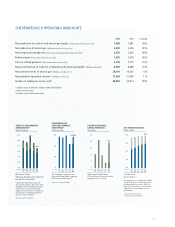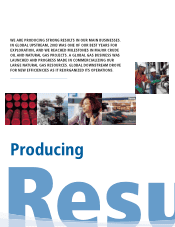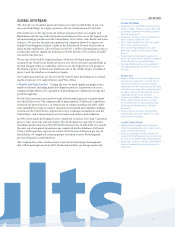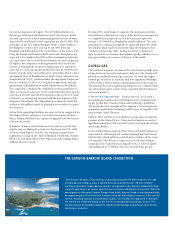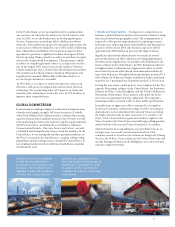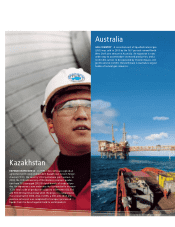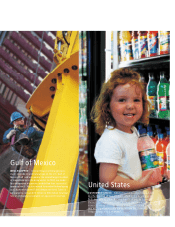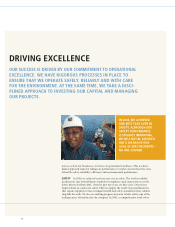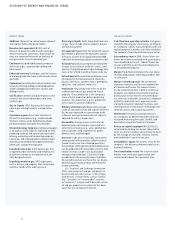Chevron 2003 Annual Report Download - page 17
Download and view the complete annual report
Please find page 17 of the 2003 Chevron annual report below. You can navigate through the pages in the report by either clicking on the pages listed below, or by using the keyword search tool below to find specific information within the annual report.
15
management system was put in place and new companywide guidelines
issued to promote safe driving habits.
RELIABILITY When people, processes and equipment perform depend-
ably, there is less chance of injury and environmental damage and less
chance of lost revenue. In 2003, ChevronTexaco developed and deployed
tools and processes to improve operating reliability. Early results are show-
ing benefits in all sectors of the business, from lower maintenance costs and
downtime to greater pipeline reliability and improved refinery efficiencies.
THE ENVIRONMENT At ChevronTexaco, we integrate environmental
considerations into business decisions, always seeking new ways to mini-
mize pollution and waste, conserve natural resources, and enhance our
understanding of how our business may affect the environment.
As part of this effort, the company tracks the amount of energy consumed
in its operations. In 2003, we used 1 percent less energy than the previous
year, representing savings of $28 million. Since 1992, the year we began
tracking, we have reduced companywide energy use by 22 percent.
A wholly owned subsidiary, Chevron Energy Solutions (CES), works
with external partners and internal business units to help them find and
implement ways to save energy in their operations. In late 2003, the U.S.
Department of Defense and the U.S. Department of Energy awarded CES
multiple performance-based contracts to engineer and install facility
improvements at three military bases. The improvements are expected to
save U.S. taxpayers at least $151 million and reduce greenhouse gas emis-
sions by approximately 1.5 million tons.
In 2003, significant progress was made in reducing the number and
volume of oil spills. Over the year, the company experienced 1,145 spills,
nearly 25 percent less than in 2002. The volume spilled was 26,500 barrels,
a 50 percent reduction from the previous year. Less than 1 percent of the
spilled oil went to water and a little more than half of the total spilled
volume was recovered immediately. In all instances, areas affected by spills
were cleaned up and remediated. The company has set a goal to reduce
spills by 20 percent per year through 2006.
In 2003, we developed comprehensive software to estimate and manage
greenhouse gas emissions. In an effort to standardize and compare emis-
sions data, we are distributing the software at no charge to others in the
industry. At the end of 2003, approximately 80 companies and organiza-
tions had requested copies of our emissions software.
STEERING PROJECT
SUCCESS
In 2004, ChevronTexaco’s capital and
exploratory budget is estimated to be
$8.5 billion. We follow a disciplined
approach to ensure that these funds are
directed toward the highest-quality
opportunities with the greatest potential
for enabling growth and increasing stock -
holder value.
We evaluate opportunities through the
ChevronTexaco Project Development and
Execution Process, a project manage-
ment method that is considered one of the
industry’s best. The process not only helps
us to identify the best projects, but also
to execute them well. It is used in front-
end engineering work to identify potential
problems, as well as to improve scheduling
and minimize late changes.
We also conduct peer reviews to share best
practices. These reviews can help accelerate
a project or lead to a new approach.
An example is the deepwater Agbami Field,
a major c r ude o il d e ve lopment off sh ore
Nigeria. A project team, along with our
tech nology and services company, enhanced
the ori gi nal development plan by fi nding
greater effi ciencies in the drilling, design
and construction of the project. The fi ndings
of the peer review are now being applied in
developing the giant Tahiti Field in the U.S.
Gulf of Mexico.
In the U.S. Gulf of Mexico (far left), a dedicated team of experts trained in
reliability engineering is helping to predict and prevent equipment and proc-
ess failures on approximately 400 platforms.
Aviation personnel in Taiwan (near left) were among thousands of global
downstream employees who took part in ChevronTexaco’s International
Safety Day. The event identifi ed safety enhancements that are now being
adopted throughout our downstream operations.
IMPROVING RELIABILITY


